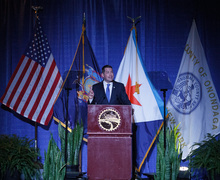University Place promenade proves beneficial, so far
Jessica Sheldon | Photo Editor
The University Place promenade is the new pedestrians-only walkway that was completed shortly before students returned to campus.
As Syracuse University students settle into the Hill this week, they will meet new classmates, new professors, new neighbors and the same campus with a new look.
Costing an estimated $6 million, the now-completed promenade on University Place is a car-free walkway intended for pedestrians only: the campus buses that used to stop in front of the Schine Student Center and Bird Library are permanently rerouted to Waverly Avenue and only emergency vehicles are permitted to pass.
The promenade is part of the Campus Framework plan, one of three components of Chancellor Kent Syverud’s 20-year-long Fast Forward Syracuse initiative. It was to be constructed at a time when the university needed to replace the water main on University Place. At the same time, the reasoning behind its introduction was to beautify the campus and make it more accessible as well as walkable. SU also added a heating capability to the sidewalks that will melt snow during the winter.
While the SU community has not yet seen the promenade in full swing, the walkway has proven to be a positive change to the campus so far. Now that cars no longer cut through campus along University Place, students are able to converge, travel and mingle across a centralized location. And instead of being an awkward addition to the infrastructure of the campus, the promenade fits in like a missing puzzle piece. There are even beneficial outcomes to the change in bus routes, considering the grouping of buses at College Place is more straightforward and the stop is now even more of a hub for campus transportation.
Despite the good that the promenade has brought to SU, not all of the community has been on-board with project. Within the past year, complaints have surfaced about a lack of administrative transparency, a disregard for disability accessibility and poor judgment in allocating funds toward the project.
In May, 108 faculty members signed a petition denouncing the promenade and speaking to these complaints. Petition-signers called the decision-making process was “hasty and methodologically” unsound, and said the project itself would be a dramatic renovation of the campus. They also spoke about the disruption of traffic. SU staff were joined by students in a protest in front of Crouse-Hinds Hall later that month.
Apart from criticisms of the planning process, it is important to note that there is room for concern when it comes to the safety of students in regard to conflicting means of transportation: the skateboarders and bikers weaving through the crowds of people on the promenade could pose a bodily threat to those traveling by foot or wheelchair.
What’s more is that college-aged students glued to their phones on the way to class could further endanger themselves and increase their chances of collision. Heading into the fall, the administration should consider planting signs or sending out a campus-wide email outlining promenade rules in regard to skateboarding or biking, if not creating a separate promenade lane.
There is also the question of how snow on the promenade will be handled: for the snow that doesn’t melt with the heated sidewalks, where will the rest of it be shoveled? That process should keep SU community members with disabilities in mind in order to maintain utmost accessibility.
While not perfect, the promenade serves its purpose of creating a more aesthetically-pleasing and geographically unified campus. Sure, there will be a learning curve. As the SU student body and staff get accustomed to the walkway, a culture will develop from travel patterns. Only time will definitively tell how the SU community interacts with and on the promenade.
But most importantly, this renovation is a tangible, concrete milestone that has been reached in the 20-year quest to complete the Campus Framework.
Published on August 28, 2016 at 11:02 pm
Contact: opinion@dailyorange.com





